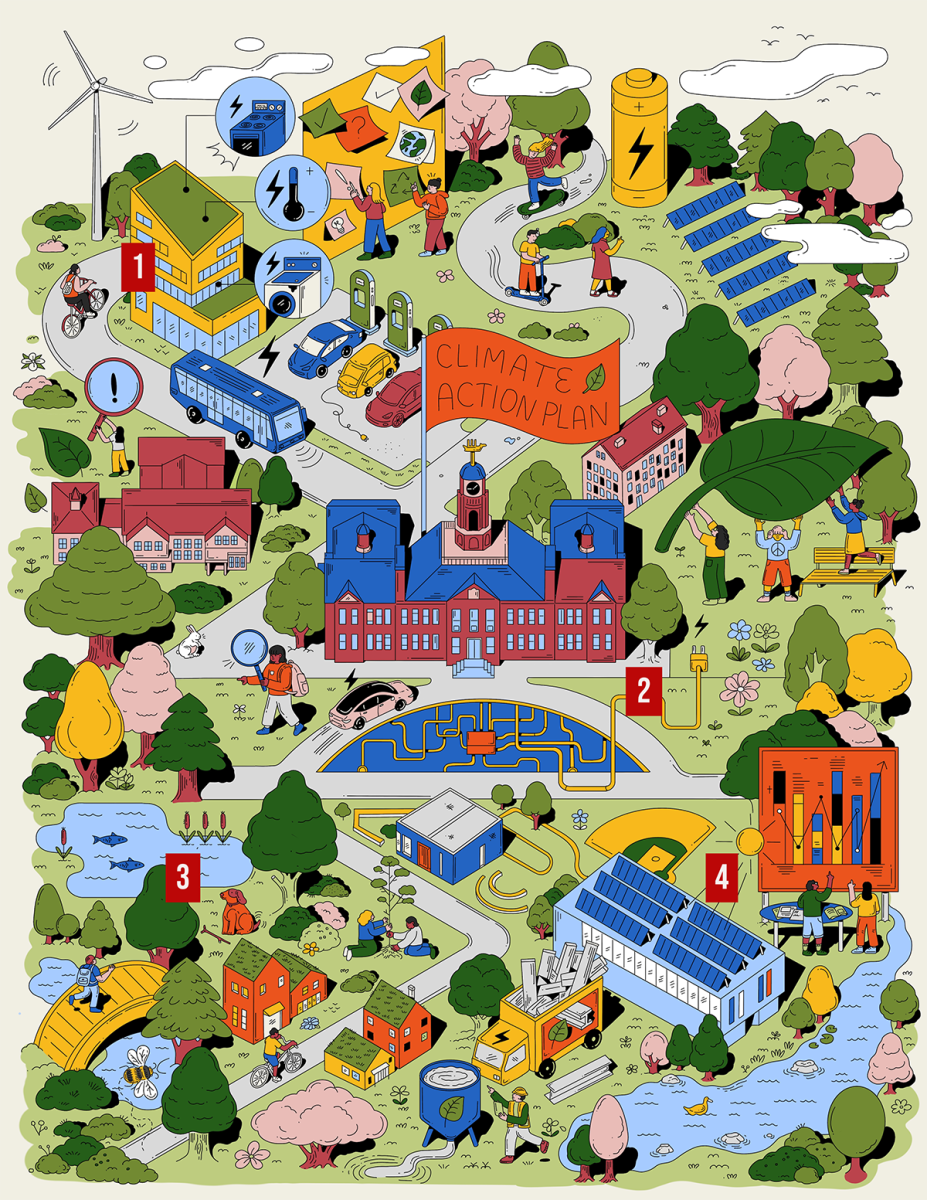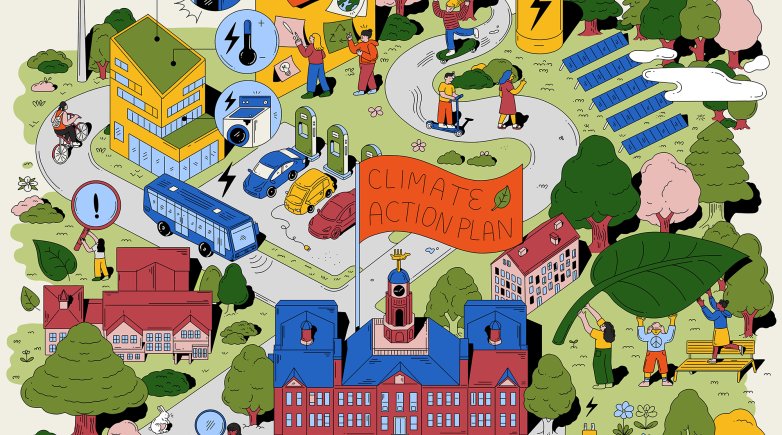For the sustainable future
Exeter releases its first sustainability and climate action plan.
Exeter’s founding document predates the advent of the principles of sustainability by about 200 years, but today the ideals of each seem inextricable.
Just as the philosophy of non sibi calls on Exonians to use the wisdom gained at the Academy for others as well as for oneself, the concept of sustainability recognizes that our actions have consequences beyond ourselves. Exonians are motivated by non sibi to face the challenges of their day, and there are perhaps no greater challenges facing society today than the matter of sustainability and the crisis of climate change.
It is amid these challenges that Exeter publishes its first comprehensive sustainability and climate action plan, “a road map for a community-wide commitment to action.” Titled Building From Strength Toward a Zero Carbon Future, the document quotes the Intergovernmental Panel on Climate Change in calling the climate crisis “a grave and mounting threat to our well-being and a healthy planet.”
 The document begins with a refreshed environmental mission statement and three overarching goals, then lays out a strategy to achieve them. “If Exeter is to create a truly sustainable campus and meet our responsibilities to future generations, we must set goals that match the urgency and scope of the climate crisis,” the document declares. The plan — endorsed in concept by the Trustees in January and made final this spring — leans on the good work done by the Exeter community over the last two decades and a campus culture of conservationism prevalent since Exonians commemorated the first Earth Day 53 years ago. It also recognizes that the immediacy and complexity of climate change has grown since the school’s adoption of an environmental mission statement in 2004. “Consequently,” the plan reads, “our commitment to reducing our environmental impact and educating our students [on the issue] has increased, and must continue to increase.”
The document begins with a refreshed environmental mission statement and three overarching goals, then lays out a strategy to achieve them. “If Exeter is to create a truly sustainable campus and meet our responsibilities to future generations, we must set goals that match the urgency and scope of the climate crisis,” the document declares. The plan — endorsed in concept by the Trustees in January and made final this spring — leans on the good work done by the Exeter community over the last two decades and a campus culture of conservationism prevalent since Exonians commemorated the first Earth Day 53 years ago. It also recognizes that the immediacy and complexity of climate change has grown since the school’s adoption of an environmental mission statement in 2004. “Consequently,” the plan reads, “our commitment to reducing our environmental impact and educating our students [on the issue] has increased, and must continue to increase.”
The document quotes Principal Bill Rawson ’71; P’08: “Just as we continually re-examine every aspect of Exeter life to ensure we are the best version of ourselves and living up to our founding principles, we must reassess our commitment to sustainability and our impact on the environment.”
The new environmental mission statement, revising an original from 2004, says:
Phillips Exeter Academy is committed to fostering a culture of sustainability in our community. Through our academic programs, we educate our students about the principles of sustainability and the threat of climate change and cultivate their capacity to take action. Through our operations, we will continue to manage our natural resources and campus facilities responsibly, reduce our environmental impact, and minimize our contributions to climate change.
The three overarching goals call on the school to:
1. Ensure that every student graduates from Exeter with a fundamental understanding of the principles of sustainability and the issues posed by climate change.
2. Reduce scope 1 and 2 carbon emissions (from a 2005 baseline) 75 % by 2031 and achieve zero carbon emissions by 2050.
3. Integrate principles of sustainability into all Exeter programs and operations.
The plan dedicates a chapter to each goal: Education; Emissions and Energy; and Sustainability Integration. The chapters lay out where the school stands in each area and how it intends to achieve the stated goal. The text is the product of more than a year of work by Principal Rawson and the Environmental Stewardship Committee, led by Warren Biggins, manager of sustainability and natural resources, and Andrew McTammany ’04, an instructor in science and the school’s sustainability education coordinator. The 23-page document was completed in March, but the desire for bold vision on the subject is long-standing.
“The Academy has been thinking about sustainability for a long time,” says Biggins, who came to Exeter in 2019 after working in the sustainability department at Pitzer College in California. “My position has existed for over 10 years. There have been various attempts at some sort of a sustainability master plan.” The newly published plan establishes Exeter as a leader among secondary institutions, Biggins says, adding: “On the college and university level, it’s pretty much par for the course at this time. At the high school level, it’s going to be early, and it’s going to be really, really ambitious.”
“All Exonians understand that the climate crisis is one of the most pressing issues of our time, but few know exactly what they can do about it,” says Safira Schiowitz ’23, co-head of Exeter’s Environmental Action Committee. “I hope that the climate action plan will encourage students to find unique ways to contribute to climate change mitigation.”
Building from strength
More than just a vision for the future, the plan confirms the strength of the Academy’s foundation on the subject of sustainability. The Courses of Instruction boast 12 sustainability-oriented classes across disciplines, including Regenerative Agriculture, Earth and the Climate Crisis and Literature and the Land. Student clubs like the Environmental Action Committee and Exeter Climate Lobby have long championed the cause of a sustainable Exeter, and the school’s Global Initiatives program offers students a variety of experiential and immersive opportunities related to the environment.
 The school has made significant progress in curbing greenhouse gas emissions, slashing output by nearly 60% since 2005. Eight buildings use geothermal wells for heating and cooling, and a solar array installed in 2018 atop William Boyce Thompson Field House has generated an annual average of 575,000 kilowatts of electricity, enough to power 54 homes.
The school has made significant progress in curbing greenhouse gas emissions, slashing output by nearly 60% since 2005. Eight buildings use geothermal wells for heating and cooling, and a solar array installed in 2018 atop William Boyce Thompson Field House has generated an annual average of 575,000 kilowatts of electricity, enough to power 54 homes.
Since 2008, Exeter has constructed six LEED-certified buildings, including the gold-standard field house and The David E. and Stacey L. Goel Center for Theater and Dance. The 12-unit faculty housing development being built on High Street uses all-electric construction, avoiding HVAC and appliances reliant on fossil fuels.
Impressive headway, certainly, but the climate action plan pushes the community to “aim higher and act more ambitiously,” and puts the institution’s intentions on the record. “It gives us something to point to when we’re doing something new,” Biggins says. “When we’re building a new building, when we’re replacing a vehicle, when we’re replacing some piece of grounds equipment. Having the formalized approved plan is really a nice tool to have to achieve the goals that we want to achieve on campus.”
Dr. Ira Helfand ’67, a trustee who advised Principal Rawson and the committee throughout the plan’s creation, adds, “It represents a clear commitment to prepare our students to be leaders in the difficult transition that humanity will have to make if we are going to avoid the most catastrophic consequences of climate change.”
Digging into the plan
The document’s first chapter purposefully focuses on education. The committee acknowledges that Exeter’s “primary contribution to climate action is through climate education.” The Academy’s environmental footprint
is infinitesimal in global terms, but Exonians who are well-informed about the science and potential solutions of climate change can have a great effect on society.
The plan does not create new courses or academic or extracurricular programs. That process will be led by the faculty with input from students. “It will embolden our faculty to design new curricular experiences around sustainability,” McTammany says. “It will empower our students to propose field courses and projects that center environmental issues. Our teachers won’t just be teaching content, they’ll inspire purpose and prepare our students to be difference makers. And that’s something our faculty are already really good at.”
The educational goals include working with student groups to design and implement projects such as dorm composting and wetland restoration, and developing sustainability-related internships through the alumni network. Bea Burack ’21, a sophomore at Dartmouth College who spent four years at Exeter working to raise awareness about the threat of climate change and who is currently helping revise Dartmouth’s climate action plan, calls the stated goal to educate students in an interdisciplinary fashion “promising but vague,” adding, “I’m wondering how it will be executed.” She says she hopes the school will offer more specifics as the plan evolves, but she fully supports the proposal to expand internship opportunities. “I interned at the Conservation Law Foundation after my upper year, through a program supported by Exeter,” she recalls. “That was a transformative and fascinating experience for me and has driven my continued interest in pursuing a career as an environmental lawyer.”
The second chapter of the plan is multilayered and dedicated to emissions and energy. The first layer calls for reducing emissions — direct (scope 1) or indirect through purchased electricity (scope 2) — by 75% from a 2005 baseline by 2031. As noted, the Academy has made great strides toward this goal already, and Biggins calls the aim “very achievable and realistic.”
The second element of the emissions goal targets achieving zero carbon emissions by 2050. To quantify just how ambitious this aim is, consider that even though the institution has cut its emissions from fossil fuels, it still emitted more than 10 metric tons of carbon dioxide into the atmosphere last year. Eliminating that will require fresh ideas.
“It’s important to aim so high because it’s what the best available science tells us we have to do,” Biggins says. “Not as just the Academy, it’s what civilization has to do to avoid the worst effects of global climate change.”
 Biggins says that if one were to build PEA from scratch today, achieving zero carbon would be in the blueprints. “You’d have your buildings heated and cooled via heat pump, and your water heated via heat pump,” he says.
Biggins says that if one were to build PEA from scratch today, achieving zero carbon would be in the blueprints. “You’d have your buildings heated and cooled via heat pump, and your water heated via heat pump,” he says.
“Whether that’s air source heat pump or geothermal heat pump, those technologies exist and are available. You would also have an electric vehicle fleet. The charging station infrastructure is all available. … For the most part, the grounds equipment technology is there. And then what are you left with? Well, you’re left with supplying the electricity needed to power everything via renewable electricity. That technology exists too.”
It is a more daunting task to convert an Exeter nearing its 250th anniversary. Some of its 2 million square feet of buildings date to Grover Cleveland’s second presidential term. “It’s a radical re-imagining of our building systems at a real large scale,” Biggins says. “And that’s why we’ve got to start thinking about this stuff because it’s not something that can be done in a summer.”
The third goal, sustainability integration, focuses on the day-to-day operations of the school and its community. From quantifying the amount of water used and developing strategies to reduce consumption, to adding electric-vehicle chargers at parking locations across campus, to increasing campus’ waste diversion rate, every facet of campus life is considered.
'A living document'
The plan is meant to be updated at least every five years with progress reported against the stated goals. Biggins calls the plan “a living document” and says its next iteration will have more specifics informed by the work that is done. “We’re going to be updating it in a formal way to guide our steps through the next five, 10, 15, 20 years on the way to 2050,” he says. As the plan states in the concluding paragraph, “our actions will determine whether or not we achieve our goals.”
Helfand, the Academy trustee, calls the plan an essential and praiseworthy first step. “Along with the danger of nuclear war, the climate crisis is one of the two great existential threats facing humanity today,” he says. “How we deal with these threats will be the defining narrative of the 21st century.
“Some of the steps that we have to take will be expensive and they will involve sacrifice. But the science is clear. Exeter and society as a whole are going to have to make major changes in the way we live. I am very proud that the Academy is addressing this challenge head-on.”
This story was originally published in the Spring 2023 issue of The Exeter Bulletin.
Imagine Exeter in 2050
Here’s what our zero carbon campus might look like:
1. Everything will run on electricity! From our fleet of campus vehicles (buses, gators, pickups) and equipment (snowblowers, lawn mowers) to appliances (stoves and clothes driers in faculty housing). Charging stations will be omnipresent.
2. The all-electric heating and cooling systems will be powered by geothermal wells rather than fossil fuels.
3. Expanded climate education curriculum inspires new student-led projects on campus, like dorm composting and wetland restoration.
4. Solar panels on academic buildings and residences will generate clean, renewable behind-the-meter electricity, supplemented by off-campus power purchase agreements and renewable energy certificates.

